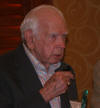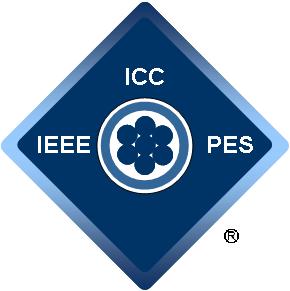
The ICC Website is changing. As this transition is made, our new format
can be found at www.pesicc.org/ICCWP.
Please send any comments or questions to
mvh@voncorp.com.
Joseph H. (Joe) Snow ,
,
September 10, 1920- April 19,
2014
2011 Dr. George H. Bahder Memorial
Award
1991 ICC Distinguished Service Award
Obituary, published
in "The Facts", April 22, 2014
The son of the late Joseph H. Snow, Sr. and Ada C. Snow was 93 years young,
having been born on September 10, 1920, and departing from this life on April
19, 2014. A fourth generation Texan, he was living in Angleton, Texas at the
time of his departure, his residence being only a few blocks from the place he
was born. Except for his tour of duty in WWII and a 10 year assignment with Dow
Chemical at its headquarters in Midland MI, he lived in Texas all of his life.
He is survived by his beloved wife of 63 years, Ellen “Pinky” Snow, his three
children, Joellen Snow (and husband Stan O’Neal), Joseph H. Snow III (and wife
Jamie), and Edie Snow Myer (and husband Austin), 12 grandchildren (his
granddaughter, Ellen Ada Snow predeceased him in 2001), and 5 great
grandchildren
Career Highlights
- Joseph H. (Joe) Snow graduated from Texas A and M University, College Station,
Texas, in December, 1941 with a Bachelors Degree in Electrical Engineering.
-
First Lieutenant, U S Army Signal Corps, 1942 -1945: During World War II, Joe
was a leader of a unit responsible for providing radar protection and guidance
to the US Forces in the Pacific. He was first stationed in Molokai, Hawaii and
then on Saipan where his radar unit tracked and guided B-29 long range bombers
from and to Isley Field.
- Chief Electrical Engineer, The Dow Chemical Company, Freeport, TX 1946-1961:
Joe
began his career in the Texas Operations where he was involved in the
engineering and design of the power system for the Texas chemical production
location. Under his leadership, the Freeport plant location was one of the first
in the world to convert its medium-voltage cables from varnished cambric
insulation to polyethylene insulation. The first use of polyethylene was not
without its problems. The cables began to fail by treeing from water that had
been trapped inside the conductor during cable production. He played a
significant role in defining the problem and working with cable manufacturers to
correct the problem. It was this work that led him to become an expert in cable
design and materials.
- Market and Business Manager, Wire and Cable, The Dow Chemical Co., 1961-1978:
Joe was involved in the development of many materials for wire and cable
applications as the first market and business manager for their wire and cable
business. The paper “The Evolution of Sheath Constructions for Communications
Cable” is significant, because it showed for the first time the extent to which
plastic coated metals enabled the development of the bonded sheath for providing
moisture protection to cable. A revolution was taking place in the cable
industry at the time because of the invention of functional plastic coated
shielding materials and their initial use in bonded sheaths for cable. Joe was
heavily involved as a driver to build a plant to manufacture these materials and
with the cable makers by providing the assurance needed to commercialize
innovative cable designs based on the new material technology. An addendum to
the above paper, “A Note on the Sensitivity of Bonded Jackets to Flaws in
Construction,” was especially significant to the further development of bonded
sheath cable, because it quantitatively defined the role of the bonded jacket
and sealed overlap in providing moisture protection to the core of the cable.
Joe led the customer activities required to manufacture the first
medium-voltage power cable prototype having a bonded sheath with coated copper.
The design led to the development of a better understanding of the behavior of
the bonded sheath under thermal loading, and the role of thin tapes for short
circuit protection.
- Senior Engineering Manager, The Dow Chemical Company, 1978-1981:
Joe provided leadership to the engineering function on the use of
chemical-moisture barrier cables in underground cable systems as described in
the paper “Chemical Moisture Barrier Cable for Underground Systems”. This paper
is significant because it documents the first use of low and medium-voltage
cables with a bonded sheath of coated aluminum in an underground system of an
industrial plant. The entire electrical system was placed underground for safety
reasons, and all low voltage instrument, control and medium voltage cables were
protected with bonded sheaths to prevent chemical and moisture attack. The cable
system engineering was also his responsibility, and he worked with their
research and development groups and several cable manufacturers to design and
manufacture the cables. He provided the engineering practices to bury the cable
in trenches filled with cement stabilized sand. This plant design was then
implemented in several other petrochemical plants along the Gulf coast.
After lightning strikes became a major problem at chemical plants along
the Gulf coast by causing the destruction of electronic instruments and
controls, Joe led the commercialization activities to provide low voltage
instrument and power cables with a heavier gauge (8 mils) coated aluminum shield
grounded at both ends. The combination of heavier shield and ground
configuration acted to cancel out the interference currents generated by the
lightning.
- Senior Engineering Associate, Anixter, Inc., 1981-2010
As
a Senior Engineering Associate with Anixter, Joe played a leadership role in
developing supplier partnerships between Anixter and their clients. He
represented Anixter at the ICC where he continued to make significant
contributions to the development of chemical-moisture barrier cable.
Joe was responsible for the commercialization of chemical-moisture barrier
cables for petrochemical plant applications. The cables and their development
are described in the paper “Chemical-Barrier Cable – Concept and Practice”. This
paper is significant because it documents the first industrial use of 5 kV and
15 kV cables with a bonded sheath with coated copper where the copper acted as
both a moisture barrier and electrical shield to the cables. He provided the
leadership with the cable manufacturers on the cable designs, manufacture and
commercialization of the MV cables. He worked with an accessory equipment
manufacturer on the termination devices for the shield and training of the
personnel involved with installation of these devices. He led the effort on
developing the specifications for the cables, manufacturing and testing of the
cables and cable management during the installation of the cables.
Awards
- ICC Dr. George H. Bahder Memorial Award 2011
- ICC Distinguished Service Award 1991
- IEEE/PES Outstanding Working Group Award 1996
Professional Activities
-
Meeting 46, Spring 1970 to Meeting 67, Fall, 1980, Joe Snow is the chair of
Subcommittee 6. Under his leadership the P532 jacket guide and the P635
aluminum sheath guide are initiated and published. The P1777 guide on
concentric neutral corrosion is initiated.
-
Meeting 52, Spring 1973 to Meeting 66, Spring 1980, Joe Snow chairs Project
9-31 on “Low Voltage Instrumentation and Control Cables.” This project helps
integrate the technology associated with industrial tray cables into the ICC
technology base.
-
Meeting 70, Spring 1982 to Meeting 102, Fall 1997, Joe Snow chairs Project
6-23, “Properties of Laminate Sheaths” which meets jointly with two other
discussion groups to provide a forum on all cable designs, technology and
cable materials that can help ward off the adverse effects of moisture on
underground cables.
-
Meeting 77, Fall 1985 to Meeting 97, Spring of 1995, Joe Snow chairs WG 6-23
and under his leadership the P1142 “Guide on the Design, Testing, and
Application of Moisture Impervious, Solid Dielectric, 5-35 kV, Power Cable
Using Metal/Plastic Laminates” is published.
-
Meeting 86, Spring 1990 to Meeting 105, Spring 1999, Joe Snow chairs Project
9-39, “Liaison with IAS/PCIC on Cable Guide for Cable Plants” which results
in the publication of the P1242 “Guide for Specifying and Selecting power,
Control and Special Purpose cable for Cable Plants.” Joe Snow plays a major
role in writing and leading the development of the guide.
-
Meeting 109, Spring 2001 to Meeting 127, Spring 2010, Joe Snow chairs WG
A11W and under his leadership completes an exhaustive revision of the P1142
“Guide for the Selection, Testing, Application and Installation of Cables
Having Radial Moisture Barriers and Longitudinal Water Blocking.”
Publications
-
“The Evolution of Sheath Constructions for Communications Cable,” R. C.
Mildner, W. R. Ropp, J. H. Snow, 15th International Wire and
Cable Symposium, Atlantic City, N. J., December, 1966.
-
“A Note on the Sensitivity of Bonded Jackets to Flaws in Construction,” R.
C. Mildner, W. E. Ropp, J. H. Snow, Addendum to the above Paper, 15th
International Wire and Cable Symposium, Atlantic City, N. J., December,1966.
-
“Chemical Moisture Barrier Cable for Underground Systems,” K. E. Bow, J. H.
Snow, IEEE Transactions on Power Apparatus and Systems, July, 1982, Vol.
PAS-101, No. 7, (ISSN 0018-9510). (This paper was also published in the
Record of Conference Papers for the Transmission and Distribution
Conference).
-
“Wire and Cable Update – 1984,” J. W. Frasure, J. H. Snow, D. A. Voltz,
Record of Conference Papers, IAS, Petroleum and Chemical Industry
Conference, !984.
-
“Underground cable – designs extend life”, Joseph H. Snow, Electric Light
and Power, June, 1988.
-
“Progress in the Development of Medium Voltage Power Cable with Moisture
Barriers,” J. H. Snow, J. Quevedo, Paper IX-Reu-1987-23, IEEE –Section
Mexico, Conference on Transmission and Distribution of Electrical Energy,
Ixtapa, Zihautanejo, Mexico, Nov., 1987 (English and Spanish)
-
“International Standardization Activities for Moisture Impervious Cables,”
K. E. Bow and J. H. Snow, Third International Conference of Polymer
Insulated Cables, Jicable ’91, Versailles, France, June 24-28, 1991, pp.
183-190
-
“Wire and Cable Update -1990,” M. G. Bayer, K. E. Bow, J. H. Snow, Paper No.
PCIC-90-3, Record of Conference Papers, IAS, Petroleum and Chemical Industry
Conference, Houston, TX, Sept. 10-12, 1990, pp.19-29
-
“Design, Testing and Application of Moisture Impervious Cable,” K. E. Bow
and
-
J. H. Snow, Proceedings of the 1991 IEEE/PES Transmission and Distribution
Conference, 91CH 3070-0, Dallas, TX, Sep. 22-27, 1991, pp.143-150
-
“Wire and Cable Update – 1991, ” M. G. Bayer, K. E. Bow, J. H. Snow, and D.
A. Voltz, IEEE Transactions on Industry Applications, Vol. 28, No. 1,
January/February 1992, pp. 211-220. (This paper was also published in the
Record of Conference Papers of the IAS/PCIC).
-
“Performance and Economic Considerations in Selecting and Applying Quality
Medium Voltage Cables,” J. H. Snow, ICC Summer Meeting, No. 91, Birmingham,
England, July 20-23, 1992.
-
“Specifying, Selecting, and Testing Quality Cable,” K. E. Bow, J. H. Snow,
D. A. Voltz and W. D. Wilkins, IEEE Transactions on Industry Applications,
May/June, 1993, Vol.29, No. 3, pp. 631-638. (This paper was also published
in the Record of Conference Papers of the IAS/PCIC).
-
“Chemical-Moisture Barrier Cable – Concept and Practice,” M. G. Bayer, K. E.
Bow, J. H. Snow, D. A. Voltz, IEEE Transactions on Industry Applications,
Vol. 31, No. 6, November/December 1995. (This paper was also published in
the Record of Conference Papers of the IAS-PCIC).
-
“A New Era in Cable Designs and Materials to Resolve Environmental Issues,”
R. E. Barras, K. E. Bow, J. H. Snow and D. A. Voltz, Record of Conference
Papers, 96CH35988, IAS, Petroleum and Chemical Industry Conference,
September 23-25, 1996, Philadelphia, PA, pp. 269-279
-
“Guide for Specifying and Selecting Power, Control and Special Purpose Cable
for Petrochemical Plants – What’s in It and How Will It Help You,” D. A.
Voltz, J. H. Snow, Record of Conference Papers, IAS, Petroleum and Chemical
Industry Conference, 2000.
Return to the ICC Homepage page
IEEE prohibits discrimination, harassment and bullying. For more
information, visit
ieee.org/web/aboutus/whatis/policies/p9-26.html
Privacy & Opting Out of Cookies
Terms & Conditions
IEEE ICC PES & Design is a registered trademark of
The Institute of Electrical and Electronics Engineers, Inc.



 ,
, 